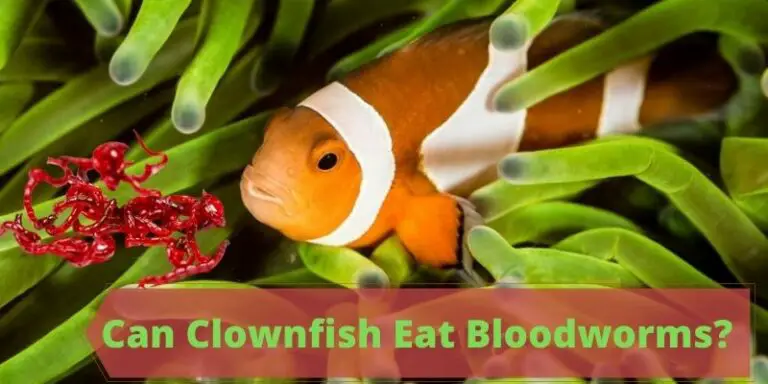What Do Baby Clownfish Eat & What To Feed? (Diet & Foods)
Baby clownfish are small in size, and they need to be fed nutritious foods that will help them to grow properly. Many fishkeepers have asked the question about what do baby clownfish eat?
Baby clownfish can eat various types of food, including pellets, flakes, brine shrimp, rotifers, etc. Read further to know why these are considered to be suitable foods for baby clownfish.
Baby Clownfish Eating Behavior
The clownfish breeding process is an adventure, and several discoveries are made during this process. Eating behavior for baby clownfish is one of the various aspects that should be focused on from Day 1 of the breeding process.

Baby clownfish have different eating behavior depending upon whether they are in the wild or captivity. In captivity, they are mainly fed with rotifers, phytoplankton, and copepods.
You can buy all three from the store or online, and the first two can be cultured in a special process.
The baby clownfish shows viciousness when fed with food. In the wild, they will be alive on phytoplankton and other micro-organisms rather than rotifers. Phytoplankton and micro-organism are present in the ocean naturally.
While food is served to baby clownfish, their focus is more on fighting with their peers than enjoying food. As a result, a good amount of food will sink and stick to the bottom.
What To Feed Baby Clownfish?
In captivity, they only need fresh and live food to survive. It means you can’t serve flakes, palettes, frozen, or human food to your baby clownfish.
In captivity, the baby clownfish can get its nutrition from different food items such as rotifers, phytoplankton, copepods, and brine shrimp. But they will not eat any dry food.
Rotifers
You need to be proficient in creating a food web to grow live rotifers, phytoplankton, and copepods.
Rotifers are a perfect size food to feed baby clownfish. But rotifers do not contain any good nutritional value. Rotifers can be produced, but they need a lot of maintenance.
It includes changing the water daily and, to make it nutritious, feed small fish rotifers with phytoplankton.
Phytoplankton
Phytoplankton is full of nutritional values but a little big to serve to baby clownfish. Alternatively, phytoplankton is used to create rotifer cultures, and then a more nutritious rotifer is served to baby clownfish.
Copepods
Copepods are a much healthier option for feeding baby clownfish but are expensive and hard to find. Moreover, producing copepods is a slower and challenging process compared to rotifer production.
Brine shrimp
Brine shrimp is not an ideal food, but it can be served to baby clownfish. It can also be cultured at home to feed as a live food to baby clownfish.
Pallets and Flakes
At a later stage, pallets and flakes can be introduced to baby clownfish which are full of nutrition for a grown-up clownfish.
Palettes or flakes should be served in a minimal amount at the start. You can feed 5 to 6 pieces of each and gradually increase the quantity as baby clownfishes grow.
How To Feed Baby Clownfish?
Newly hatched clownfish fry can survive without food for the first day. Don’t hesitate to serve freshly cultured rotifers to your baby clownfish from day 2 onwards. They will show savageness when served with food in a high-density pond.
Feeding clownfish needs special care in terms of quantity and quality of food. Overfeeding your baby clownfish may lead to its death.
Knowledge of proper serving amounts is a must for the victorious development of clownfish. They need premium quality and fully nutritious food to survive.
How Often To Feed Baby Clownfish?
The baby clownfish are more eager towards food for their health as they get bigger. They need more nutrition as they are growing and more in number inside a pond.
Ideally, baby clownfish should be served 3 to 4 times daily for their healthy growth and energetic movement in the pond.
They can survive at least 2 days without new food served to them. But it can affect baby clownfish health and growth to an alarming extent.
How Much To Feed Baby Clownfish?
You can add live food to aquarium water with approximately 5 to 15 rotifers per millimeter of aquarium water.
At a later stage, brine shrimp are also introduced to baby clownfish. Always serve fresh brine shrimp to them to avoid any diseases or health risks.
Can Baby Clownfish Eat Brine Shrimp?
Baby clownfish need special care and nutritious food serving in the early stage of their life. In wildlife, they survive on all-natural food available. In the aquarium, they need special live food cultured at home, or you can order it from stores.
Brine shrimp is another live food that you can serve to baby clownfish. You can buy it from the store, or you can culture at home.
If you feed brine shrimp older than 12 hours, it will pollute your pond water and carry potential risks to baby clownfish wellbeing.
Ideally, brine shrimp should be served fresh because baby clownfish only grow well if served with fresh food. So, it’s better to culture the brine shrimp at home on a daily basis. You should also not refrigerate it for more than 12 hours.
Brine shrimp are less nutritious as compared to other live food items such as rotifers, phytoplankton, and copepods. If you do not feed brine shrimp to your baby clownfish, they can survive on rotifers and after phytoplankton.
Final Thoughts
Feed baby clownfish various types of foods as discussed above. For the healthy growth of baby clownfish, you should feed them more with live food.
Live food includes rotifers, phytoplankton, and copepods which you can buy from stores or online. Otherwise, these can be cultured at home through a series of steps.





